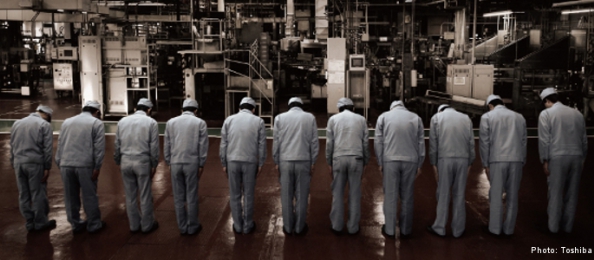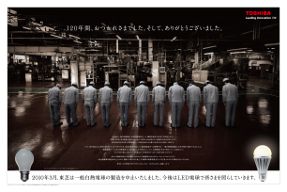Cultivating a New Era of Lighting – In Harmony with the Earth
March 17, 2010, was a landmark day for Toshiba – a simple flick of a switch brought an end to 120 years of production of general-use incandescent bulbs, a product that Toshiba was the very first to manufacture in Japan.
The end of production for 103 different kinds of incandescent bulbs came a year ahead of the original plan. This move is expected to contribute to an annual reduction in CO2 emissions of 430,000 tons compared to 2008, when Toshiba shipped about 20 million units. In an effort to become one of the world’s foremost eco-conscious companies, Toshiba is, at present, focusing on environmentally friendly lighting such as LED lighting.
“After 120 years in this business, lighting is in Toshiba’s DNA. Now, capitalizing on Toshiba Group’s comprehensive, advanced technological capabilities, we will promote lighting that delights people and contributes to the environment.”
Norio Sasaki, President
As part of efforts to counteract climate change
In order to hasten the shift to a low-carbon society and to make a positive contribution to the global environment, Toshiba Lighting and Technology Corporation (TLT), a unit of Toshiba Corporation, decided to end production of general-use incandescent bulbs in 2008. As it did, it shifted its focus to accelerating promotion of environmentally friendly LED (light emitting diode) lighting, which it had succeeded in commercializing in 2007.
On March 17, 2010, TLT held a ceremony at its Kanuma factory in Japan to mark the end of production of general-use incandescent bulbs after 120 years. On that day, it ended production of 103 types of incandescent bulbs, excluding certain special-purpose bulbs. This step was taken far in advance of 2012 – the Japanese government’s target year for ending domestic production and sales of incandescent bulbs – and a full year ahead of Toshiba’s own original plan. In 2009, Kanuma was turning out some 7 million incandescent bulbs a year, and earning good revenues with very cost-efficient product. At that time, LED lamps were very new to the market and cost some 50 to 70 times more than incandescent bulbs. The decision to end production was indeed a critical one for Toshiba. However, Toshiba was aware of the significance of the step as being part of its efforts to mitigating climate change. The transition from incandescent bulbs to LED and fluorescent lamps is expected to bring down CO2 emissions by 430,000 tons a year compared to the benchmark year of 2008, when some 20 million incandescent bulbs (including imports) were shipped. At the production termination ceremony, the then-president of TLT addressed the employees, stressing that, “Today is not the end but marks the start of a new chapter of Toshiba’s lighting history. Let’s work together to create new lighting and promote it in Japan and throughout the world.” Following the speech, the final production line was stopped, an event that was broadcast live at the Kanuma factory. Closing the ceremony, Mr. Norio Sasaki, the President of Toshiba Corporation, emphasized the need to “cultivate a new era of lighting” and Toshiba’s determination to become one of the world’s most eco-conscious companies.
Japan’s first incandescent bulb manufacturer
Back in 1890, Ichisuke Fujioka, one of the leading engineers of his age, established Hakunetsu-sha & Co., one of the founding companies of today’s Toshiba, as Japan’s first incandescent bulb manufacturer. From initial production of 10 bulbs a day, annual production grew remarkably, peaking at 78 million in 1973, and Toshiba recorded cumulative shipments of 4.07 billion bulbs over 120 years of production. In 1980, Toshiba developed the world’s first ball-shaped compact fluorescent lamp (CFL), in response to the increasing awareness of the need to save energy following the oil shocks of the 1970s. As CFLs increased in popularity, production of incandescent light bulbs began to decline from around 2000.
Looking ahead
Toshiba has been a forerunner in the movement to discontinue production of incandescent bulbs. Toshiba is now directing its attention on promoting energy-efficient LED lamps, which have longer service lives of around 40,000 hours and reduce CO2 emissions by approximately 80 percent when compared with incandescent bulbs. The transition to LED lighting is one of the steps toward realizing Toshiba’s Environmental Vision 2050 – the envisioning of the ideal situation in 2050: a world where people live richer lifestyles in harmony with the earth.
Pretty Shrestha is CSR Implementation Office at Toshiba.
About Us // Privacy Policy // Copyright Information // Legal Disclaimer // Contact
Copyright © 2012-2018 macondo publishing GmbH. All rights reserved.
The CSR Academy is an independent learning platform of the macondo publishing group.











